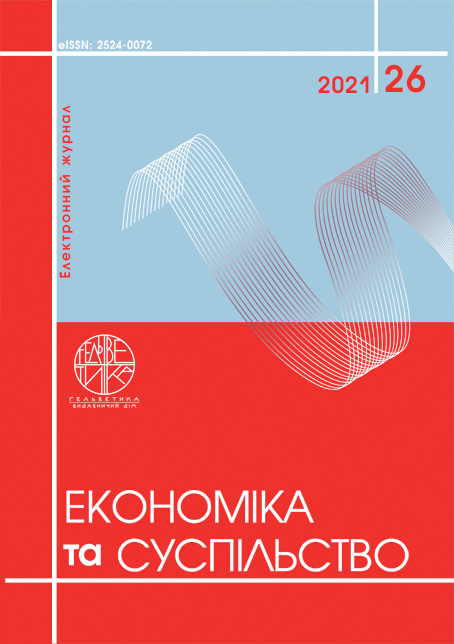EUROPEAN COHESION POLICY: CONCEPTUAL PRINCIPLES, IMPERATIVES FOR UKRAINE
Abstract
The article is devoted to the research of European cohesion policy conceptual and applied bases, which can be successfully implemented in Ukraine. The relevance of the study is due to the high level of Ukrainian regions divergence in terms of socio-economic development, the problems of territorial integrity, ethnic, religious and cultural conflicts. The methodological basis of the research is formed by the dialectical method of cognition of economic processes in their interrelation and evolution. The main innovative changes in the cohesion policy for the programming period 2021-2027 have been identified. They are a reaction to the strengthening of global risks and internal threats to the EU unity. The study proves the feasibility of implementation a European model of сohesion policy as a means of activation and accumulation of internal regional development opportunities. Based on the use of practiced in the countries of the European Union indicators, an assessment of Ukrainian regions economic, social and territorial cohesion is performed. On the basis of factor analysis the interdependence of economic, social and territorial cohesion is proved. This proves the objective need to increase the economic cohesion of all Ukrainian regions as a basis for overcoming disparities in social development, strengthening unity and overcoming socio-cultural and other conflicts. It is established that all administrative regions of Ukraine are characterized by a low level of social and territorial cohesion. Accordingly, the priorities set in the European Union's cohesion policy (innovation, environmental friendliness, unity, social orientation, proximity to citizens) should be strategic imperatives in Ukraine. Cohesion policy should be implemented transparently, with clearly defined goals, tools and conditions for supporting local initiatives, based on the consolidation of the state and territorial communities resources. The practical value of the study is in the possibility of using the results to substantiate differentiated proposals for overcoming disparities in the socio-economic development of the regions of Ukraine and developing of communication networks between them.
References
Ashmarina, S., Horák, J., Vrbka, J., Šuleř, P. (2021). EU Cohesion Policy 2021–2027: New Tools to Foster European Integration? URL: https://www.ncbi.nlm.nih.gov/pmc/articles/PMC7971617
Bacthler, J., Mendez, C., Wishlade, F. (2019). Reforming the MFF and Cohesion Policy 2021-27: pragmatic drift or paradigmatic shift? URL: http://www.eprc-strath.eu/Publications.html
Cohesion Policy 2021–2027. (2020). A further step towards flexibility & simplification. URL: https://www.espon.eu/sites/default/files/attachments/3%20DG%20Regio%20Post2020%20-%20Maria%20Soumela.pdf
Dąbrowski, M., Spaans, M., Fernandez-Maldonado, A., & Rocco, R. (2021). Cohesion Policy and the citizens’ perceptions of the EU: the role of communication and implementation, European Planning Studies, рр. 827-843.
European Commission. (2017). Boosting growth and cohesion in EU border regions. Brussels. URL: https://ec.europa.eu/regional_policy/sources/docoffic/2014/boosting_growth/com_boosting_borders.pdf
European Commission. (2017). My Region, My Europe, Our Future. Seventh report on economic, social and territorial cohesion. Brussels. URL: https://ec.europa.eu/regional_policy/sources/docoffic/official/reports/cohesion7/7cr.pdf
Growing regions, growing Europe – Fourth progress report oneconomic and social cohesion. (2007). Luxemburg: Office for Official Publications of the European Communities. 222 p.
New Cohesion Policy. (2020). URL: https://ec.europa.eu/regional_policy/en/2021_2027/
Questions and Answers on the EU Cohesion policy legislative package 2021-2027. (2020). URL: https://ec.europa.eu/commission/presscorner/detail/en/QANDA_20_2381
White paper on the Future of Europe. Reflections and scenarios for the EU 27 by 2025. (2017). URL: https://op.europa.eu/en/publication-detail/-/publication/ba81f70e-2b10-11e7-9412-01aa75ed71a1/language-en
Глосарій Європейської Комісії. URL: https://ec.europa.eu/regional_policy/en/policy/what/glossary/c/cohesion-policy
Державна стратегія регіонального розвитку на 2021-2027 роки від 5 серпня 2020 р. № 695. URL: https://zakon.rada.gov.ua/laws/show/695-2020-%D0%BF#Text
Державна стратегія регіонального розвитку на період до 2020 року від 6 серпня 2014 р. № 385. URL: https://zakon.rada.gov.ua/laws/show/385-2014-%D0%BF#Text
Зінчук Т., Куцмус Н. Політика згуртування ЄС: задум, еволюція, критика. Науковий вісник Чернівецького університету. 2020. Випуск 825 Економіка. С. 3-11.
Оржель, О. (2010). Економічне, соціальне і територіальне згуртування ЄС: від концепції до індикаторів.
Оржель, О. (2010). Концепція економічного, соціального та територіального згуртування Європейського Союзу пост-лісабонського періоду.
Оржель, О. (2012). Концептуальні підходи до визначення соціального згуртування. URL: http://www.dridu.dp.ua/zbirnik/2012-01(7)/12ooyvsz.Pdf
Офіційний сайт Державного комітету статистики України. URL: http://www.ukrstat.gov.ua/
Офіційний сайт Європейської комісії. URL: https://ec.europa.eu/regional_policy/en/2021_2027/.
Пошедін О. Європейська політика згуртування 2021–2027: орієнтири для України. Збірник наукових праць НАДУ. 2019. Випуск 2. С. 107–112.
Ashmarina, S., Horák, J., Vrbka, J., Šuleř, P. (2021). EU Cohesion Policy 2021–2027: New Tools to Foster European Integration? Retrieved from: https://www.ncbi.nlm.nih.gov/pmc/articles/PMC7971617
Bacthler, J., Mendez, C., Wishlade, F. (2019). Reforming the MFF and Cohesion Policy 2021-27: pragmatic drift or paradigmatic shift? Retrieved from: http://www.eprc-strath.eu/Publications.html
Cohesion Policy 2021–2027. (2020). A further step towards flexibility & simplification. Retrieved from: https://www.espon.eu/sites/default/files/attachments/3%20DG%20Regio%20Post2020%20-%20Maria%20Soumela.pdf
Dąbrowski, M., Spaans, M., Fernandez-Maldonado, A., & Rocco, R. (2021). Cohesion Policy and the citizens’ perceptions of the EU: the role of communication and implementation, European Planning Studies, рр. 827-843.
European Commission. (2017). Boosting growth and cohesion in EU border regions. Brussels. Retrieved from: https://ec.europa.eu/regional_policy/sources/docoffic/2014/boosting_growth/com_boosting_borders.pdf
European Commission. (2017). My Region, My Europe, Our Future. Seventh report on economic, social and territorial cohesion. Brussels. Retrieved from: https://ec.europa.eu/regional_policy/sources/docoffic/official/reports/cohesion7/7cr.pdf
Growing regions, growing Europe – Fourth progress report oneconomic and social cohesion. (2007). Luxemburg: Office for Official Publications of the European Communities. 222 p.
New Cohesion Policy. (2020). Retrieved from: https://ec.europa.eu/regional_policy/en/2021_2027/
Questions and Answers on the EU Cohesion policy legislative package 2021-2027. (2020). Retrieved from: https://ec.europa.eu/commission/presscorner/detail/en/QANDA_20_2381
White paper on the Future of Europe. Reflections and scenarios for the EU 27 by 2025. (2017). Retrieved from: https://op.europa.eu/en/publication-detail/-/publication/ba81f70e-2b10-11e7-9412-01aa75ed71a1/language-en
Hlosarii Yevropeiskoi Komisii. Retrieved from: https://ec.europa.eu/regional_policy/en/policy/what/glossary/c/cohesion-policy
Derzhavna strateghija reghionaljnogho rozvytku na 2021-2027 roky vid 5 serpnja 2020 r. # 695. Retrieved from: https://zakon.rada.gov.ua/laws/show/695-2020-%D0%BF#Text (in Ukrainian)
Derzhavna strateghija reghionaljnogho rozvytku na period do 2020 roku vid 6 serpnja 2014 r. # 385. Retrieved from: https://zakon.rada.gov.ua/laws/show/385-2014-%D0%BF#Text
Zinchuk, T., Kucmus N., (2020). Polityka zghurtuvannja JeS: zadum, evoljucija, krytyka. Naukovyj visnyk Chernivecjkogho universytetu, Vypusk 825 Ekonomika, S. 3-11. (in Ukrainian)
Orzhelj, O. (2010). Ekonomichne, socialjne i terytorialjne zghurtuvannja JeS: vid koncepciji do indykatoriv.
Orzhelj, O. (2010). Koncepcija ekonomichnogho, socialjnogho ta terytorialjnogho zghurtuvannja Jevropejsjkogho Sojuzu post-lisabonsjkogho periodu.
Orzhelj, O. (2012). Konceptualjni pidkhody do vyznachennja socialjnogho zghurtuvannja. Retrieved from: http://www.dridu.dp.ua/zbirnik/2012-01(7)/12ooyvsz.Pdf (in Ukrainian)
Oficijnyj sajt Derzhavnogho komitetu statystyky Ukrajiny. Retrieved from: http://www.ukrstat.gov.ua/ (in Ukrainian)
Oficijnyj sajt Jevropejsjkoji komisiji. Retrieved from: https://ec.europa.eu/regional_policy/en/2021_2027/.
Poshedin, O. (2019). Jevropejsjka polityka zghurtuvannja 2021–2027: orijentyry dlja Ukrajiny. Zbirnyk naukovykh pracj NADU, Vypusk 2, S. 107-112. (in Ukrainian)


